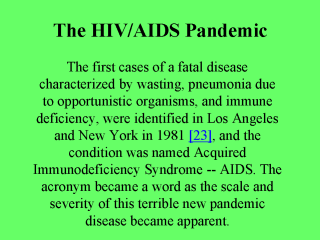| front |1 |2 |3 |4 |5 |6 |7 |8 |9 |10 |11 |12 |13 |14 |15 |16 |17 |18 |19 |20 |21 |22 |23 |24 |25 |26 |27 |28 |29 |30 |review |
 |
Discoveries
about the nature, natural history, epidemiology, and ecology, of AIDS progressed at
remarkable speed. Enough was known about its epidemiology in the homosexual community for
some moderately effective health educational counter-measures to begin almost before the
causative organism, human immunodeficiency virus (HIV) was identified in 1983 by Luc
Montagnier and his colleagues[24] at l'Institut
Pasteur in Paris. Meantime in Africa south of the Sahara, HIV was rampaging through urbanizing communities in the new nations just as they were gearing up for a dramatic economic and professional recovery from the colonial era. The long incubation time between infection with HIV and the onset of frank AIDS -- it can be at least 20 years -- means that HIV-infected people have abundant time to spread the virus to their intimate friends and casual acquaintances, often without knowing they are infected. Among homosexual men in North America and Europe, and in Africa south of the Sahara, HIV was spread by the combination of promiscuous sexual encounters, abraded genital mucosal surfaces, and bizarre sexual preferences such as "fisting" (thrusting a clenched fist into the rectum) among gay men; and the use in some African cultures of astringent herbs to dry out the vagina and increase the friction of intercourse, thus allegedly enhancing sexual pleasure. More efficient ways to spread HIV by sexual contact could hardly be invented! An even more efficient way to spread HIV arose when it got into blood products like Factor 8, used to treat hemophilia. This is one of the great tragedies of our time, aggravated by moral bankruptcy on the part of public officials in some countries. |
| front |1 |2 |3 |4 |5 |6 |7 |8 |9 |10 |11 |12 |13 |14 |15 |16 |17 |18 |19 |20 |21 |22 |23 |24 |25 |26 |27 |28 |29 |30 |review |